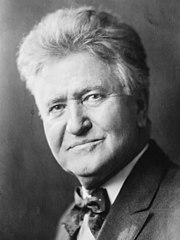1924 United States presidential election
The 1924 United States presidential election was the 35th quadrennial presidential election, held on Tuesday, November 4, 1924. In a three-way contest, incumbent Republican President Calvin Coolidge won election to a full term. Coolidge was the second vice president to ascend to the presidency and then win a full term.
531 members of the Electoral College
266 electoral votes needed to win
Coolidge had been vice president under Warren G. Harding and became president in 1923 upon Harding's unexpected death. Coolidge was given credit for a booming economy at home and no visible crises abroad, and he faced little opposition at the 1924 Republican National Convention. The Democratic Party nominated former Congressman and ambassador to the United Kingdom John W. Davis of West Virginia. Davis, a compromise candidate, triumphed on the 103rd ballot of the 1924 Democratic National Convention after a deadlock between supporters of William Gibbs McAdoo and Al Smith. Dissatisfied by the conservatism of both major party candidates, the newly formed Progressive Party nominated Senator Robert La Follette of Wisconsin.
In a 2010 book, Garland S. Tucker argues that the election marked the "high tide of American conservatism", as both major candidates campaigned for limited government, reduced taxes, and less regulation.[2] By contrast, La Follette called for the gradual nationalization of the railroads and increased taxes on the wealthy, policies that foreshadowed The New Deal.
Coolidge won a landslide victory, taking majorities in both the popular vote and the Electoral College and winning almost every state outside of the Solid South. La Follette won 16.6% of the popular vote, a strong showing for a third-party candidate, while Davis won the lowest share of the popular vote of any Democratic nominee in history. This was one of only three elections with more than two major candidates where any candidate received a majority of popular votes cast, the others being 1832 and 1980. This is the most recent election to date in which a third-party candidate won a non-southern state. This was also the US election with the lowest per capita voter turnout since records were kept.[3]




